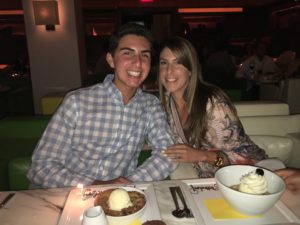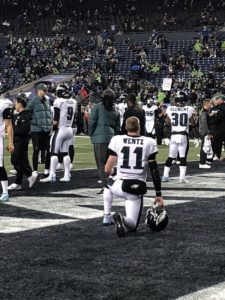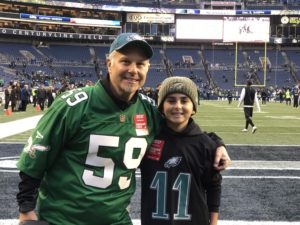I remember the sunrise over the Mediterranean on our last day in Israel. From the balcony of our hotel the contrast of brilliant colors was amazing.
I captured this moment on my iPhone and it will always remind me of a precious family vacation. This concept of moments got me to reflect on the last year both personally and professionally. I asked myself, “what goes into creating a special moment for another?”. This post is about moments and why creating them is critical and powerful in business and life. Over the past few weeks I’ve been reflecting on personal and professional moments that have had an impact on me and others, and I was moved to share these thoughts with you. I hope these thoughts compel you to create moments for others.
Let’s start with a few concepts in business and then I’ll share a few of my own family stories. Some of this motivation came from books and podcasts, but the truth is that I’ve been reflecting on 2017 which was a very special year. I came across Chip and Dan Heath’s new book called The Power of Moments, and in less than a week I heard a podcast featuring Joey Coleman who discussed moments. Moments are fleeting, but they provide opportunities to create a special situation for another person. They happen all too often without people putting much time and energy into them, and it got me thinking. It’s actually really easy to create special moments for others.
In the work environment we have tremendous opportunities to create moments for people. The first day for a new hire or the first experience after a client purchases your product. These narrow windows of time have the potential to create a positive, indelible and emotional impact on another. Creating a welcoming environment for a new employee is a great way to get that person engaged by ensuring a level of comfort in a stressful situation. What does it take to create this moment? First, have the basics set up for the employee before they arrive for day one, and have their area set up if they are working in an office setting. Take time to send out a welcome email to the team and new employee with some insights as to the type of work that the new employee is taking on and remind team members to stop by and say hello. Take an additional step and schedule 1-1 meetings for the new employee to meet key functional team members and those people who will work closely with the new employee throughout the organization. Make that first week a memorable experience for the new employee. Create that moment.
Another chance to create a moment is right after a client has purchased your solution. It’s important to celebrate your success. The sale is your moment and you’ve earned it so go out and enjoy it, and ring that bell! Take it one step further and remember that the person who bought your product now has to use it. Help to create a positive experience for your champion. The first 90 days after any purchase is the critical time to create a positive experience. From the minute the new clients get access to your product or service, you want those initial moments to be flawless.
Here are some things to consider in getting it right. Send a welcome letter with links to training materials that help the client get a fast start. Ensure that the client knows that support is close at hand and get them comfortable with their account team. Tie things together with a simple use case for the client to make the first experience of your product a good one. What else can help you stand out? Try a hand written note sent to the client to thank them for support, and if your budget allows, a small token of appreciation like a $5 gift card. I’ve often used coffee gift cards and include a message like “once you’ve had a few chances to use the service, let me buy you coffee so you can share your experience with me.” That extra touch helps to create the moment for your client. You’ll feel pretty good too.
Here’s a final thought related to business and then I’ll share some personal moments. I’ve been inviting clients to my annual kick-off meetings to speak about the state of the profession, and it’s always well received by our business because people love to hear from experts. That said, getting an expert to take time out of their busy schedule is a huge commitment, especially for someone who has daily billing pressure like many of my attorney clients. When I make the invitation to a client, I want them to have a memorable experience with us and it’s equally important to make it valuable for my team. We have a narrow window to create a moment. Here are some of the tips and tricks to make a client visit special. Take time to think through your reasons for inviting a client to participate, and be vividly clear about the reason for the invitation and what you hope to cover and convey during the event. Spend time researching the person and their interests in order to help others get to know your VIP before the event, and make sure you give your team a bio and other personal facts so that your team can engage the VIP at the event. Make your VIP feel special. To add a nice touch, send your VIP a small gift to help them remember their visit with you. We held an event in New Orleans a while back and we sent our panelists coffee and beignets from the world famous Café Du Monde. It was a small token of our appreciation so that they’d remember their time with us.
As a professional you have the power to create these moments that leave a lasting impression for your business partners, and it’s no different in your personal life. Taking the time to create special moments for your loved ones is simple, reflecting on them is precious. The past year was incredibly challenging and rewarding. My family had a number of experiences that created priceless moments that we’ll always remember when we look back. Here are three special and eternal moments worth sharing.
Dinner at Barclay Prime: His first year in high school was a wakeup call. Max decided to take a full load of honors courses for his first year at PWHS, and he put a ton of time into homework and studying to ensure that he put himself in the best position to get all “A’s”. It was a taxing year with schoolwork and a number of extracurricular activities, but Max is a goal oriented kid and doesn’t need outside motivation to stay focused. He wanted all A’s and he knew he could do it so I decided to hang an extra incentive out there for him. If you know Max, you know how much he loves a good steak. So I made the offer: get straight A’s and get your first Kobe steak. At the end of the year when the grades came in, Max comes into my office and says “Kobe steak here I come.” On the afternoon of our dinner you could see the look on his face. He was beaming with excitement knowing that his hard work was about to be rewarded. Dinner at Barclay Prime is always an experience starting with the service, and then followed with amazing popovers, choice of knife, and the best steak in Philly.  Max ordered the 10oz Wagyu, and when it landed on the table he was ecstatic with a grin from ear to ear.
Max ordered the 10oz Wagyu, and when it landed on the table he was ecstatic with a grin from ear to ear.
The video (Max Wagyu) of him taking that first bite was a moment that we will always remember. He worked so hard, and the moment was amazing for him and for the rest of us as we watched him enjoy the experience. Sharing the Wagyu was definitely a different story.
Eagles Game in Seattle: In case you didn’t know, Ashton bleeds green as a Philadelphia Eagles fan.  He loves the Birds and all things NFL, and you might even think that his world revolves around pro football. It just so happened that Ashton’s 13th birthday in 2017 coincided with the Eagle’s game in Seattle and I wanted to create a special surprise for him. I started my research, and then said to Bonnie that I was going to surprise him with a trip to Seattle to see the game as a birthday present. It was an opportunity to create a moment for America’s #1 football fan. I booked the hotel and flights, and popped the surprise on him in early July. He was beyond excited and you could see the look of awe on his face when he heard the news. A game in Philly would have been great, but traveling to Seattle with his dad to see the birds play at CenturyLink was a memory for life.
He loves the Birds and all things NFL, and you might even think that his world revolves around pro football. It just so happened that Ashton’s 13th birthday in 2017 coincided with the Eagle’s game in Seattle and I wanted to create a special surprise for him. I started my research, and then said to Bonnie that I was going to surprise him with a trip to Seattle to see the game as a birthday present. It was an opportunity to create a moment for America’s #1 football fan. I booked the hotel and flights, and popped the surprise on him in early July. He was beyond excited and you could see the look of awe on his face when he heard the news. A game in Philly would have been great, but traveling to Seattle with his dad to see the birds play at CenturyLink was a memory for life. 
Fast forward to a few days ahead of the trip, and some other amazing things were lining up to make this an unbelievable trip…the Birds were 10-1 going into the game and we were all thinking about a deep run into the playoffs. On top of that, a close friend scored us pre-game field passes to watch the Eagles practice up close. Every part of the trip was special, and watching Ashton enjoy this special trip will last forever.
Bar Mitzvah on Masada: This third moment happened early on the morning of December 27th on top of Masada as Ashton and Hayden became bar mitzvahs.  There were so many amazing stories to share about our 2 week family trip to Israel. We were headed there for Ashton’s bar mitzvah, and over the course of 14 days we took in the historic sites of Jerusalem, Tel Aviv, and Tiberias. We we experienced floating in the Dead Sea, making bread with Bedouins, making chocolate on a kibbutz, and living the experience of the underground bullet factory.
There were so many amazing stories to share about our 2 week family trip to Israel. We were headed there for Ashton’s bar mitzvah, and over the course of 14 days we took in the historic sites of Jerusalem, Tel Aviv, and Tiberias. We we experienced floating in the Dead Sea, making bread with Bedouins, making chocolate on a kibbutz, and living the experience of the underground bullet factory. 


The country is rich in history and religious artifacts, making all of these moments special, but the bar mitzvah ceremony in the synagogue atop Masada created the most poignant moment. Ashton and Hayden had studied their parts and they read beautifully from the prayer books and torah. As the boys led the service I took a moment to look at the family sitting together in this 2000 year old chapel and I caught a glimpse of tears in the eyes of my father in law. He was overcome with emotion living the moment of the special occasion. They were tears of joy for sure, but also of something more powerful about life and mortality. When Bonnie saw this she couldn’t hold back, and for me, this moment shines the light on how strong the bond of family is. Bonnie has an amazing connection to her father and she got caught up in the emotion, but what’s truly amazing is that the twelve of us were there together living out a moment that will forever remind us of the power of family. 
Moments are powerful and fleeting, and they have the opportunity to create meaningful experiences for those around you. Taking time to create them and reflect upon them is essential to a life worth living.







